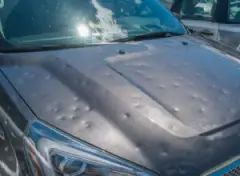
Hailstorms can strike with little warning, leaving a trail of damaged vehicles in their wake. Every year, car owners face the daunting task of assessing and repairing hail damage, a natural occurrence that can lead to significant aesthetic and functional impairments to vehicles. The time limits for filing a claim may vary by location and policy, and missing them can mean bearing the full cost of repairs yourself.
Furthermore, navigating the intricacies of insurance claims can be complex, often and car owners may want to consider professional advice. Legal assistance can prove invaluable, ensuring that claims are filed correctly and on time, and helping to dispute any denials or underpayments by insurance providers. A Boca Raton insurance claims lawyer can help you manage your hail damage claim effectively, especially if your insurer refuses to cooperate.
Hail Claims Are Time Sensitive
The time limits for filing a hail damage claim can vary widely, but most insurance policies require that claims be made promptly once the damage is discovered. Generally, insurers set a window that can range from 30 days to one year to file a claim after a hail event. This period is crucial as waiting too long can result in a denied claim, especially if further damage occurs from the delay.
These deadlines are not universally set and can differ significantly depending on the state and the individual insurance provider. Each state has its own regulations that influence insurance practices, including how long a policyholder has to file a claim. Moreover, insurance companies might have their specific stipulations embedded in the policy details, which makes it vital for policyholders to understand their policy thoroughly.
Due to these variations, vehicle owners are encouraged to review their insurance contracts closely or consult with their insurance agent to understand the specific time frames applicable to their hail damage claims. Such proactive measures ensure that claims are filed within acceptable timelines, safeguarding against potential complications.
How Do I Know if My Policy Covers Hail Damage?
Car insurance policies that cover hail damage typically fall under comprehensive coverage. This type of insurance is designed to protect vehicle owners against damages not caused by collisions but by other external events like natural disasters, theft, vandalism, and specifically, hail. Since hail can strike unexpectedly and cause significant damage, having comprehensive coverage is crucial for financial protection.
It’s essential for vehicle owners to thoroughly review their insurance policies to understand the specifics of hail damage coverage. Policies can vary significantly between different insurance companies and even among different plans offered by the same provider. Some policies might cover the total cost of repairs minus the deductible, while others may have specific limitations or exclusions related to hail damage. Additionally, the amount of the deductible and the process for filing a claim can differ.

Filing a Hail Damage Claim
Hail damage on cars refers to the physical harm caused by the impact of hailstones, which can vary widely in size and velocity. Hailstones can create small to large indentations on the hood, roof, or trunk of the vehicle. These dents are not only unsightly but can also depreciate the vehicle’s value and integrity.
Another significant type of hail damage is shattered glass. Hailstones can crack or completely break the car’s windows and windshield, posing immediate safety hazards and requiring urgent repairs. Additionally, hail can lead to paint damage, where the impact strips away layers of paint, leading to exposed metal surfaces. This exposure can quickly result in rust if not addressed promptly. In order to file a claim for any of the above damages, take these steps:
- Document the Damage: As soon as it is safe, take detailed photographs of all affected areas of your car. Capture different angles and lighting conditions to show the extent of the damage thoroughly.
- Record the Date of the Storm: Note the date and approximate time when the damage occurred as this will be required by your insurance company.
- Contact Your Insurance Company: Inform your insurer about the damage as soon as possible. Provide them with the initial details of the incident and ask about the next steps according to your specific policy.
- Collect Evidence: Besides photographs, gather any weather reports from the day of the storm to support your claim. This can act as proof that the damage was indeed caused by hail.
- Get a Damage Assessment: Have your car inspected by a professional to obtain an official estimate of the repair costs. Some insurance companies may require you to use a certified repair shop they trust or send an adjuster to assess the damage themselves.
- Submit Your Claim: Provide your insurer with the collected evidence, the professional damage assessment, and any other required documents. Follow their guidance for any additional steps needed to process your claim.
These steps, complemented by thorough documentation and prompt communication with your insurance provider, increase the likelihood of a favorable claim outcome.
Should I File a Claim for Hail Damage?
When considering whether to file a hail damage claim, assess if the damage is minor and the repair cost falls below your insurance deductible. In such cases, it may be more cost-effective to skip the claim to avoid potential premium increases. Additionally, existing damage on your vehicle can complicate new claims.
Insurance adjusters might attribute some of the new damage to pre-existing damages, which can reduce the payout or potentially lead to claim denial. Therefore, maintaining detailed records of your vehicle’s condition and any previous repairs is crucial to differentiate past damages from new hail impacts effectively.
Let Us Help With Denied Hail Damage Claims
If your auto insurance provider denies your hail damage claim, the attorneys at Ged Lawyers can be instrumental in challenging this decision. We will review your insurance policy in detail to ensure that the denial does not violate the terms of your coverage. Our team can help gather additional evidence, organize documentation, and provide a legal argument emphasizing your rights under the policy and prove that you filed your claim on time. Call us now for help.
